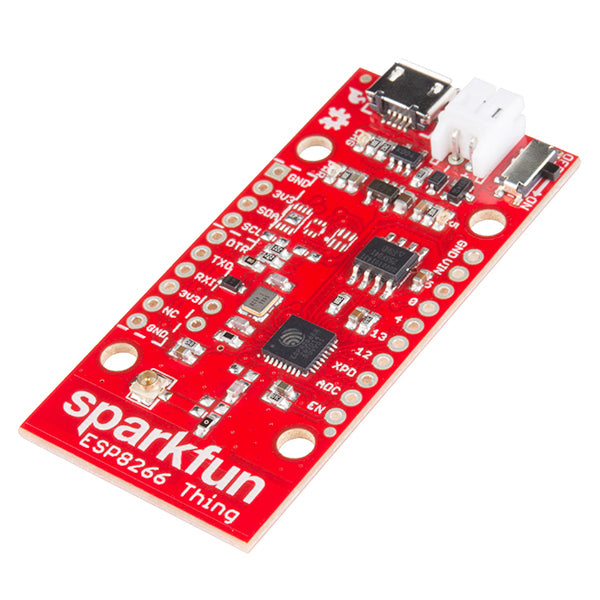
SparkFun ESP8266 Thing
£15.84
inc VAT
Original price
£13.20
-
Original price
£13.20
Original price
£13.20
£13.20
-
£13.20
Current price
£13.20
ex VAT
SKU ESP8266-THING
WRL-13231
The SparkFun ESP8266 Thing is essentially a breakout and development board for the ESP8266 WiFi SoC. Why the name? We lovingly call it the Thing due to it being the perfect foundation for your Internet of Things. Over the past year, the ESP8266 has been a growing star among IoT or WiFi-related projects. It’s an extremely cost-effective WiFi module, that – with a little extra effort – can be programmed just like any microcontroller. The only unfortunate part is: the ESP8266 has mostly only been available in a tiny, modular form, which, with limited I/O and a “unique” pin-out, can be difficult to build a project around. SparkFun’s new development board for the ESP8266 breaks out all of the module’s pins, and comes equipped with a LiPo charger, power supply, and all of the other supporting circuitry it requires.
The SparkFun ESP8266 Thing is a relatively simple board. The pins are broken out to two parallel, breadboard-compatible rows. USB and LiPo connectors at the top of the board provide power – controlled by the nearby ON/OFF switch. LEDs towards the inside of the board indicate power, charge, and status of the IC. The ESP8266’s maximum voltage is 3.6V, so the Thing has an onboard 3.3V regulator to deliver a safe, consistent voltage to the IC. That means the ESP8266’s I/O pins also run at 3.3V, you’ll need to level shift any 5V signals running into the IC. Also, with a little extra effort, the SparkFun ESP8266 Thing can be programmed using Arduino
A 3.3V FTDI Basic is required to program the SparkFun ESP8266 Thing, but other serial converters with 3.3V I/O levels should work just fine as well. The converter does need a DTR line in addition to the RX and TX pins.
Features
- All module pins broken out
- On-board LiPo charger/power supply
- 802.11 b/g/n
- Wi-Fi Direct (P2P), soft-AP
- Integrated TCP/IP protocol stack
- Integrated TR switch, balun, LNA, power amplifier and matching network
- Integrated PLLs, regulators, DCXO and power management units
- Integrated low power 32-bit CPU could be used as application processor
- +19.5dBm output power in 802.11b mode
Documents
- Schematic
- Eagle Files
- Hookup Guide
- GitHub (Design Files)
